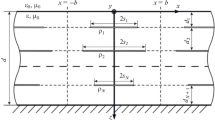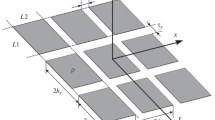Abstract
Solutions to the diffraction problems are used to calculate the effective permittivity of a composite material consisting of alternating planar arrays of square resistive patches shifted relative to each other in a dielectric layer. The relaxation character of the dispersion is demonstrated. The dispersion characteristic can be varied in wide ranges using variations in the parameters of the structure. Relative shifts of the arrays substantially affect the dispersion of permittivity of the structure. A ratio of the wavelength to the period of the structure that provides adequacy of a homogenization procedure is estimated.









Similar content being viewed by others
REFERENCES
B. F. Alimin, Zarub. Radioelektron., No. 2, 75 (1989).
H. T. Liu, H. F. Cheng, Z. Y. Chu, and D. Y. Zhang, Mater. Des. 28, 2166 (2007).
V. V. Slutskaya, Microwave Thin Films (Gosenergoizdat, Moscow, 1962) [in Russian].
Yu. N. Kazantsev and G. A. Kraftmakher, Sov. Tech. Phys. Lett. 13, 269 (1987).
V. I. Ponomarenko, I. K. Kupriyanov, and S. I. Zhuravlev, Radiotekh. Elektron. 37, 346 (1992).
V. I. Ponomarenko, Izv. Vyssh. Uchebn. Zaved., Elektromekh., No. 5, 518 (1982).
V. I. Ponomarenko, D. I. Mirovitskii, and I. F. Budagyan, Radiotekhnika 39 (11), 68 (1984).
V. I. Ponomarenko and S. I. Zhuravlev, Radiotekh. Elektron. 37, 812 (1992).
V. I. Ponomarenko, Radiotekhnika 45 (5), 82 (1990).
Yu. N. Kazantsev, V. A. Babayan, N. E. Kazantseva, O. A. D’yakonova, R. Mouchka, Ya. Vilčáková, and P. Sáha, J. Commun. Technol. Electron. 58, 233 (2013). https://doi.org/10.1134/S106422691303008X
M. Yu. Zvezdina, L. V. Cherkesova, Yu. A. Shokova, G. P. Sinyavskii, D. A. Bezuglov, G. N. Shalamov, V. I. Ponomarenko, I. M. Lagunov, S. V. Sokolova, and M. I. Matveev, Composite Materials: Development and Application, Ed. M. Yu. Zvezdin (ANS SibAK, Novosibirsk, 2017) [in Russian].
A. S. Il’inskii and A. G. Sveshnikov, Prikl. Elektrodin., No. 1, 51 (1977).
V. V. Nikol’skii and T. I. Nikol’skaya, Electrodynamics and Propagation of Radio Waves (Nauka, Moscow, 1989) [in Russian].
V. I. Ponomarenko and I. M. Lagunov, J. Commun. Technol. Electron. 62, 765 (2017). https://doi.org/10.1134/S1064226917070087
V. P. Shestopalov, L. N. Litvinenko, S. A. Masalov, and V. G. Sologub, Diffraction of Waves by Gratings (Khar’k. Univ., Khar’kov, 1973) [in Russian].
Matrix Computations, Ed. by G. H. Golub and Ch. F. van Loan, 4th ed. (Johns Hopkins Univ. Press, Baltimore, 1996).
Author information
Authors and Affiliations
Corresponding author
Ethics declarations
The authors declare that they have no conflicts of interest.
Additional information
Translated by A. Chikishev
APPENDIX
APPENDIX
Below, we present the final formulas for calculation of the RC for a plane electromagnetic wave that is normally incident on a structure consisting of square resistive patches in a dielectric layer. The wavelength is no less than the period of the structure. We employ consecutive numbering of elementary squares (ESs) of all arrays and consecutive numbering of all modes of the equivalent waveguide. Note that the TEM mode has number n = 1.
The following notation is used.
(i) xp, yp, and zp are coordinates of the p-th ES (p = 1, 2, …, P).
(ii) Γn and Wn (n = 1, 2, …, M ⋅ N) are the propagation constants and impedances for the modes of the Floquet channel at z > z0 (Fig. 2).
(iii) \(T_{n}^{ \pm }\) and \(R_{n}^{ \pm }\) are the transmission and reflection coefficients of forward (+) and backward (–) waves at the boundary z = z0 (Fig. 2).
(iv) χnx and χny are transverse wave numbers of the n-th mode.
(v) \(A_{n}^{{(y)}}\) and \(A_{n}^{{(x)}}\) are the normalized factors of electric-field components Eny and Enx of the n-th mode [13].
(vi) Snp = sin(χnxxp)sin(χnyyp).
(vii) Cnp = cos(χnxxp)cos(χnyyp).
(viii) Ψnp = \(\int_{{{\sigma }_{p}}}^{} {\cos } \)(χnxx)cos(χnyy)dxdy.
(ix) \({{\tilde {\Psi }}_{{np}}}\) = \(\int_{{{\sigma }_{p}}}^{} {\sin } \)(χnxx)cos(χnyy)dxdy,
where σp is the area of integration over surface of the p-th square.
The last integrals are easily calculated but we omit cumbersome calculated results.
(x) Cn = –Wn/(2|Wn|),
\(\beta _{{yy}}^{{p(n)}}\) = Cn|\(A_{n}^{{(y)}}\)|2Ψnp, \(\beta _{{yx}}^{{p(n)}}\) = Cn(\(A_{n}^{{(y)}}\))*\(A_{n}^{{(x)}}\)Ψnp,
\(\beta _{{xx}}^{{p(n)}}\) = Cn|\(A_{n}^{{(x)}}\)|2\({{\tilde {\Psi }}_{{np}}}\), \(\beta _{{xy}}^{{p(n)}}\) = Cn(\(A_{n}^{{(x)}}\))*\(A_{n}^{{(y)}}{{\tilde {\Psi }}_{{np}}}\).
(xi) \(E_{{nmp}}^{ \pm }\) = exp(iΓn(zm ± zp)).
(xii) αn is the reflection coefficient of the n-th mode with respect to electric field in the plane z = zk+ 1.
(xiii) \({{\tilde {S}}_{m}}\) = \(T_{1}^{ + }\)(exp(iΓ1zm) + α1exp(–iΓ1zm))/(1 – α1\(R_{1}^{ - }\)).
(xiv) Fnmp = \(R_{n}^{ - }\)[\(E_{{nmp}}^{ + }\) + αn(\(E_{{nmp}}^{ - }\) + 1/\(E_{{nmp}}^{ - }\))] + αn/\(E_{{nmp}}^{ + }\).
(xv) Snmp = exp(iΓn|zp – zm|) + Fnmp/(1 – αn\(R_{n}^{ - }\)).
(xvi) \(A_{{mp}}^{{(x)}}\) = \(\sum\nolimits_n^{} {{{S}_{{nmp}}}\beta _{{xx}}^{{p(n)}}} \)Snm – δmpρ, where δmp is the Kronecker delta.
(xvii) \(A_{{mp}}^{{(y)}}\) = \(\sum\nolimits_n^{} {{{S}_{{nmp}}}\beta _{{xy}}^{{p(n)}}} \)Cnm.
(xviii) \(B_{{mp}}^{{(x)}}\) = \(\sum\nolimits_n^{} {{{S}_{{nmp}}}\beta _{{yx}}^{{p(n)}}} \)Snm.
(xix) \(B_{{mp}}^{{(y)}}\) = \(\sum\nolimits_n^{} {{{S}_{{nmp}}}\beta _{{yy}}^{{p(n)}}} \)Cnm – δmpρ.
The SLAE for surface current densities {Ipx}, {Ipy} consists of two subsystems
(xx)
(xxi)
G = \(\frac{{{{\alpha }_{1}}T_{1}^{ + }\, + \,\sum\nolimits_p^{} {({\text{exp}}(i{{\Gamma }_{1}}{{z}_{p}})\, + \,{{\alpha }_{1}}{\text{exp}}( - i{{\Gamma }_{1}}{{z}_{p}}))({{I}_{{px}}}\beta _{{xy}}^{{p(1)}}\, + \,{{I}_{{py}}}\beta _{{yy}}^{{p(1)}})} }}{{1 - {{\alpha }_{1}}R_{1}^{ - }}}\)
is the quantity that is used to represent the RC.
(xxii) R = \(R_{1}^{ + }\) + \(T_{1}^{ - }\)G is the RC with respect to electric field in the plane z = z0
Rights and permissions
About this article
Cite this article
Ponomarenko, V.I., Lagunov, I.M. Radio Absorbing Composite Based on Square Resistive Patches. Tech. Phys. 65, 968–974 (2020). https://doi.org/10.1134/S1063784220060225
Received:
Revised:
Accepted:
Published:
Issue Date:
DOI: https://doi.org/10.1134/S1063784220060225




